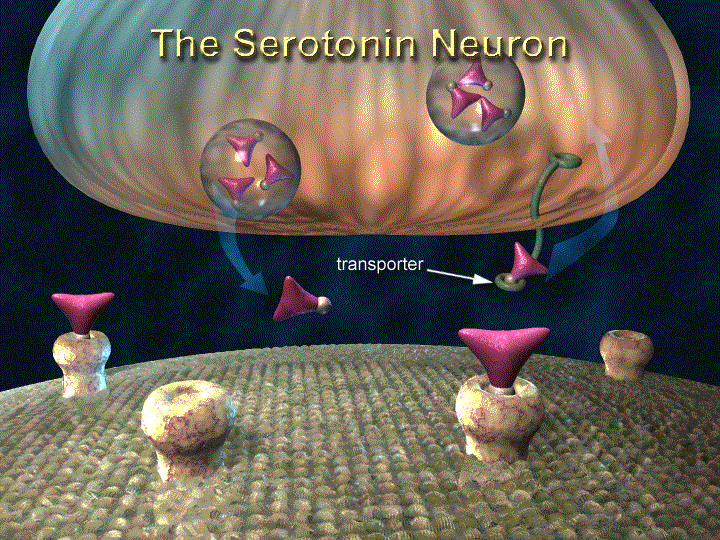Organophosphates exist throughout our environment and consequently, we are all likely to come into contact with these compounds to some extent. Evidence suggests that long-term, low-level exposure to these compounds play a role in psychiatric disorders such as anxiety and depression. However, most research has focused on the effects of short-term exposure to relatively large concentrations of organophosphates. This can produce obvious physical symptoms including seizures, paralysis or coma. Conversely, despite mounting evidence for adverse health outcomes, the effects of long-term, low-level organophosphate exposure are less well-understood. Using an interdisciplinary approach, this research explores the prevalence of mood disorders in relation to organophosphate exposure levels in humans. Furthermore, the powerful genetic model organism, Caenorhabditis elegans, is used to investigate the effects of organophosphates on brain function. Taken together, the results could inform future therapeutic approaches, while building a better understanding of psychiatric disorders and the biological mechanisms that are involved.
What are Organophosphates?
 Multiple routes for the spread of pesticides.
Organophosphates (OPs) are most commonly used as insecticide pesticides in crop protection and pest control. Additionally, they have a range of other uses, which can depend on the toxicological or pharmacological profile of each compound. Despite some differences, all organophosphates share the same mode of action; they inhibit an enzyme called acetylcholinesterase (AChE). During normal brain function, a combination of electrical and chemical signals are passed between brain cells and to other body parts such as muscles. This is how thoughts, movement and many other important processes are controlled. After a signal has been transmitted, the chemicals that carried the signal must be removed for the signal to cease. Acetylcholinesterase is responsible for clearing some of these chemicals, but organophosphates prevent it from working properly. This can cause severe disruption to the central nervous system and because the effects can be lethal, such compounds are used as active ingredients in insecticides, and have even been weaponised as nerve agents in chemical warfare. Not all organophosphates are intended to cause harm however. Many are used as industrial solvents, plasticisers or are added to lubricants like engine oil. Because of their widespread use, organophosphates can be found in food, air, household dust, in the soil and even in seawater. Some level of human exposure is therefore largely unavoidable, and yet the effects of low-levels to human health are relatively unknown.
Multiple routes for the spread of pesticides.
Organophosphates (OPs) are most commonly used as insecticide pesticides in crop protection and pest control. Additionally, they have a range of other uses, which can depend on the toxicological or pharmacological profile of each compound. Despite some differences, all organophosphates share the same mode of action; they inhibit an enzyme called acetylcholinesterase (AChE). During normal brain function, a combination of electrical and chemical signals are passed between brain cells and to other body parts such as muscles. This is how thoughts, movement and many other important processes are controlled. After a signal has been transmitted, the chemicals that carried the signal must be removed for the signal to cease. Acetylcholinesterase is responsible for clearing some of these chemicals, but organophosphates prevent it from working properly. This can cause severe disruption to the central nervous system and because the effects can be lethal, such compounds are used as active ingredients in insecticides, and have even been weaponised as nerve agents in chemical warfare. Not all organophosphates are intended to cause harm however. Many are used as industrial solvents, plasticisers or are added to lubricants like engine oil. Because of their widespread use, organophosphates can be found in food, air, household dust, in the soil and even in seawater. Some level of human exposure is therefore largely unavoidable, and yet the effects of low-levels to human health are relatively unknown.
Evidence for a Link to Psychiatric Disorders
Unsurprisingly, some of the most striking evidence for organophosphate-related disorders comes from groups known to be at higher risk of exposure. These include agricultural workers, who may experience what is known as chronic organophosphate-induced neuropsychiatric disorder (COPIND). Many War veterans from the 1991 Iraq conflict have suffered from Gulf War Illness (GWI), and similar symptoms were experienced by civilians following a Sarin gas attack on a Tokyo subway in 1995. All of these groups are likely to have been exposed to organophosphates, and each show high incidences of depression and anxiety-related neurological impairments. Suicide rates are also relatively high in these groups, but a causal role for organophosphates has been difficult to prove. For the latter groups, warfare or terrorist attacks could induce such symptoms through post-traumatic stress, even in the absence of organophosphate poisoning. Agricultural workers on the other hand, are exposed as part of their normal working routine and are therefore comparatively less likely to have suffered trauma.
In this study I am using cognitive tests and self-reporting based assessments, to investigate how mood disorders present in people that have been exposed to organophosphates. This information will be compared to people with little or no historic exposure, producing a picture of what the effects of exposure might be. Self-reporting is an extremely useful tool, which is only available when working with human participants. However, different approaches must be used to experimentally measure the effects of organophosphates on brain cells and circuits.
Using C. elegans to Investigate Neurobiological Mechanisms
 Fluorescent neurons in the head of C. elegans.
Caenorhabditis elegans - a nematode worm, was originally described as a model organism by Nobel Prize-winner Sydney Brenner in 1974. Since then it has become one of the most completely understood multicellular organisms on the planet and has even been sent into space! Every cell and connection between nerve cells in C. elegans has been identified, which is helpful for understanding how brain signals lead to actual functions. Most importantly, many of the genes and molecular processes in C. elegans function in the same way as those in humans. In C. elegans however, we have a range of tools which enable us to manipulate the genes, cells and processes that we think might be important. These tools have enabled important advances in the treatment of human conditions including Alzheimer’s disease, diabetes and depression. For example, C. elegans has helped us to understand how the anti-depressant drug Prozac works by increasing the effect of another neurotransmitter - serotonin. There are also well established methods for exploring other neurotransmitter systems, such as acetylcholine and dopamine, among many others. Of course, nobody is expecting worms to show signs of depression or anxiety; but we already know that these neurotransmitters control human mood states. By directly exposing C. elegans to organophosphates, I am investigating how these systems are effected using techniques from behavioural-pharmacology, microscopic-imaging and gene-manipulation. The results will help us to understand how organophosphates lead to psychiatric disorders in humans. They will also help to build a more thorough understanding of the biological mechanisms involved, and hopefully pave the way for improved medicines and therapeutic practices in the future.
Fluorescent neurons in the head of C. elegans.
Caenorhabditis elegans - a nematode worm, was originally described as a model organism by Nobel Prize-winner Sydney Brenner in 1974. Since then it has become one of the most completely understood multicellular organisms on the planet and has even been sent into space! Every cell and connection between nerve cells in C. elegans has been identified, which is helpful for understanding how brain signals lead to actual functions. Most importantly, many of the genes and molecular processes in C. elegans function in the same way as those in humans. In C. elegans however, we have a range of tools which enable us to manipulate the genes, cells and processes that we think might be important. These tools have enabled important advances in the treatment of human conditions including Alzheimer’s disease, diabetes and depression. For example, C. elegans has helped us to understand how the anti-depressant drug Prozac works by increasing the effect of another neurotransmitter - serotonin. There are also well established methods for exploring other neurotransmitter systems, such as acetylcholine and dopamine, among many others. Of course, nobody is expecting worms to show signs of depression or anxiety; but we already know that these neurotransmitters control human mood states. By directly exposing C. elegans to organophosphates, I am investigating how these systems are effected using techniques from behavioural-pharmacology, microscopic-imaging and gene-manipulation. The results will help us to understand how organophosphates lead to psychiatric disorders in humans. They will also help to build a more thorough understanding of the biological mechanisms involved, and hopefully pave the way for improved medicines and therapeutic practices in the future.
 Signals are passed between brain cells (neurons) in the form of various neurotransmitters. Here, the neurotransmitter serotonin (pink triangles) is released from the top cell and detected by receptors on the bottom cell. When the signal is complete, serotonin is taken back up to the first cell by a transporter. Antidepressant medicines like Prozac work by preventing this reuptake and allowing the signal to persist for longer.
Signals are passed between brain cells (neurons) in the form of various neurotransmitters. Here, the neurotransmitter serotonin (pink triangles) is released from the top cell and detected by receptors on the bottom cell. When the signal is complete, serotonin is taken back up to the first cell by a transporter. Antidepressant medicines like Prozac work by preventing this reuptake and allowing the signal to persist for longer.




Rate and Review
Rate this article
Review this article
Log into OpenLearn to leave reviews and join in the conversation.
Article reviews
Are resources licensed for you to use under the Creative Commons licence ‘Attribution-Non-Commercial-Share-Alike’ .
This means that you must meet the following three requirements to use the materials:
• Your use is ‘non-commercial’.
• You always cite The Open University and retain the name of any original authors.
• You ‘share-alike’; that is, make any original or derivative works available under the same terms as our licence to you. Derivative works must be redeposited in OpenLearn Create.
We recognise that our materials may be more effective if they are adapted or built on (e.g. translated, disaggregated, mixed with other materials, localised with new case study examples etc.). Therefore, we strive to avoid the use of the ‘No Derivative’ restriction on our content.
Hope that helps!
with best wishes,
Project Officer, OpenLearn
Great articles, these are groups of human-made chemicals that poison insects and mammals. The chemicals are the most widely used insecticides today. They are used in agriculture, the home, gardens, and veterinary practice. I like to get more on harmful contents please..
unknown - 20 October 2019 5:54pm
TYNice post. Do you mind if I quote a couple of your articles as long as I provide credit and sources back to your weblog? My blog site is in the very same niche as yours and my users would really benefit from a lot of the information you provide here. Please let me know if this okay with you. Thanks a lot and stay put for more